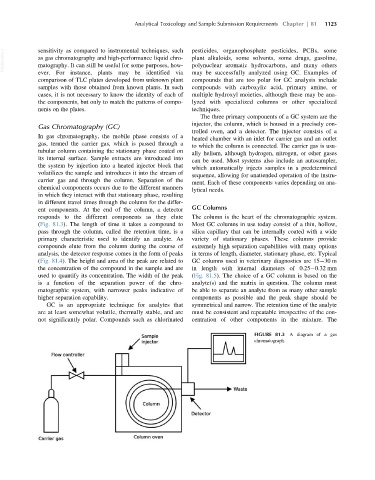Page 1191 - Veterinary Toxicology, Basic and Clinical Principles, 3rd Edition
P. 1191
Analytical Toxicology and Sample Submission Requirements Chapter | 81 1123
VetBooks.ir sensitivity as compared to instrumental techniques, such pesticides, organophosphate pesticides, PCBs, some
plant alkaloids, some solvents, some drugs, gasoline,
as gas chromatography and high-performance liquid chro-
matography. It can still be useful for some purposes, how-
polynuclear aromatic hydrocarbons, and many others
ever. For instance, plants may be identified via may be successfully analyzed using GC. Examples of
comparison of TLC plates developed from unknown plant compounds that are too polar for GC analysis include
samples with those obtained from known plants. In such compounds with carboxylic acid, primary amine, or
cases, it is not necessary to know the identity of each of multiple hydroxyl moieties, although these may be ana-
the components, but only to match the patterns of compo- lyzed with specialized columns or other specialized
nents on the plates. techniques.
The three primary components of a GC system are the
injector, the column, which is housed in a precisely con-
Gas Chromatography (GC)
trolled oven, and a detector. The injector consists of a
In gas chromatography, the mobile phase consists of a
heated chamber with an inlet for carrier gas and an outlet
gas, termed the carrier gas, which is passed through a
to which the column is connected. The carrier gas is usu-
tubular column containing the stationary phase coated on
ally helium, although hydrogen, nitrogen, or other gases
its internal surface. Sample extracts are introduced into
can be used. Most systems also include an autosampler,
the system by injection into a heated injector block that
which automatically injects samples in a predetermined
volatilizes the sample and introduces it into the stream of
sequence, allowing for unattended operation of the instru-
carrier gas and through the column. Separation of the
ment. Each of these components varies depending on ana-
chemical components occurs due to the different manners
lytical needs.
in which they interact with that stationary phase, resulting
in different travel times through the column for the differ-
ent components. At the end of the column, a detector GC Columns
responds to the different components as they elute The column is the heart of the chromatographic system.
(Fig. 81.3). The length of time it takes a compound to Most GC columns in use today consist of a thin, hollow,
pass through the column, called the retention time, is a silica capillary that can be internally coated with a wide
primary characteristic used to identify an analyte. As variety of stationary phases. These columns provide
compounds elute from the column during the course of extremely high separation capabilities with many options
analysis, the detector response comes in the form of peaks in terms of length, diameter, stationary phase, etc. Typical
(Fig. 81.4). The height and area of the peak are related to GC columns used in veterinary diagnostics are 15 30 m
the concentration of the compound in the sample and are in length with internal diameters of 0.25 0.32 mm
used to quantify its concentration. The width of the peak (Fig. 81.5). The choice of a GC column is based on the
is a function of the separation power of the chro- analyte(s) and the matrix in question. The column must
matographic system, with narrower peaks indicative of be able to separate an analyte from as many other sample
higher separation capability. components as possible and the peak shape should be
GC is an appropriate technique for analytes that symmetrical and narrow. The retention time of the analyte
are at least somewhat volatile, thermally stable, and are must be consistent and repeatable irrespective of the con-
not significantly polar. Compounds such as chlorinated centration of other components in the mixture. The
FIGURE 81.3 A diagram of a gas
chromatograph.

